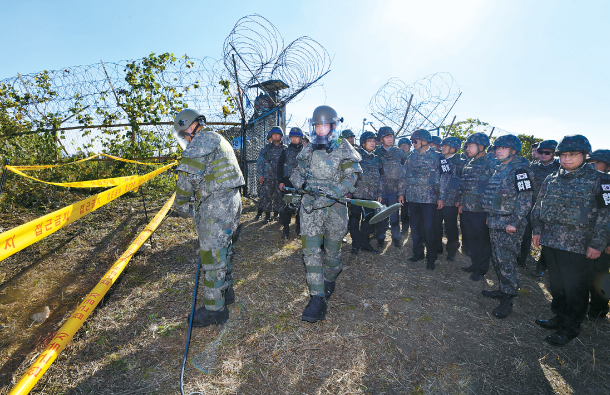Bigwigs inspect DMZ disarming

Presidential Chief of Staff Im Jong-seok, in sunglasses, accompanied by Defense Minister Jeong Kyeong-doo and Unification Minister Cho Myoung-gyon, visit a guard post at the demilitarized zone in Cheorwon County in Gangwon on Wednesday to observe a land mine removal operation at the inter-Korean border. [JOINT PRESS CORPS]
Joined by Defense Minister Jeong Kyeong-doo, Unification Minister Cho Myoung-Gyon and National Intelligence Service Director Suh Hoon, Im visited Arrowhead Ridge, or Hill 281, a scene of a notorious battle during the 1950-53 Korean War.
The visit by the high-level delegation was meant to show Seoul’s resolve to fulfill the inter-Korean agreements signed on Sept. 19 in Pyongyang between South Korean President Moon Jae-in and North Korean leader Kim Jong-un. In the Pyongyang Declaration, the two agreed to “expand the cessation of military hostilities in regions of confrontation such as the DMZ to the substantial removal of the danger of war across the entire Korean Peninsula.”
Specifically, the two Koreas agreed to remove land mines from the Korean War in the Joint Security Area (JSA) north of Seoul and part of the DMZ in Cheorwon County, Gangwon, where Arrowhead Ridge is located. The land mine removal operation began in both places on Oct. 1. The operation in the JSA, in the border village of Panmunjom, is scheduled to end Saturday. In Cheorwon, the operation is slated to continue through Nov. 30.
As an annex to the Pyongyang Declaration, the two Koreas also signed a joint military agreement in which the South and North agreed to turn the DMZ into a peace zone and disarm personnel stationed in the JSA at Panmunjom by the end of this year.
The two Koreas also agreed to conduct a joint excavation operation for remains of soldiers killed during the Korean War as well as another excavation program for historical relics in the Cheorwon area.
It is believed that an estimated 300 soldiers from the two Koreas and from the United Nations Command, which took part in the war on the South’s side, were killed in the Cheorwon border area. To bring home remains of the fallen, removing land mines is the most important step.
The joint remains retrieval project is set to run between April and October next year.
In ambitious wording, Moon proclaimed last month in Pyongyang that the two Koreas had declared a virtual end to the Korean War with their Pyongyang Declaration, in which Moon and Kim agreed to cease all confrontational acts against each other that are sources of military clashes in all domains: ground, sea and air.
In 1953, the Korean War ended in an armistice rather than a peace treaty.
Presidential Chief of Staff Im’s visit to Cheorwon Wednesday was meant to show the government’s resolve to make good on its joint agreement with the North while making its case to the international community for sanctions relief for North Korea on the condition that it takes irreversible denuclearization steps.
During a summit with French President Emmanuel Macron in Paris on Monday, Moon asked him “to play a role in the easing of United Nations sanctions when it can be determined that the North Korean denuclearization process is at least at an irreversible stage, to further encourage the North to denuclearize.”
This was the first time Moon asked a leader of a country to ease international sanctions on the North, though on a conditional basis, as Seoul has been in line with Washington’s call for complete denuclearization before sanctions relief on Pyongyang.
Following through on an agreement to disarm the JSA, militaries of the two Koreas and the United Nations Command (UNC) held their first trilateral meeting Tuesday in Panmunjom.
The South plans to withdraw five guard posts while the North removes four in the JSA. Each side also will deploy a patrol of 35 unarmed personnel. The plan also calls for allowing Koreans and foreign tourists to come across the demarcation line at the border village from 9 a.m. to 5 p.m. daily.
BY KANG JIN-KYU [kang.jinkyu@joongang.co.kr]










with the Korea JoongAng Daily
To write comments, please log in to one of the accounts.
Standards Board Policy (0/250자)